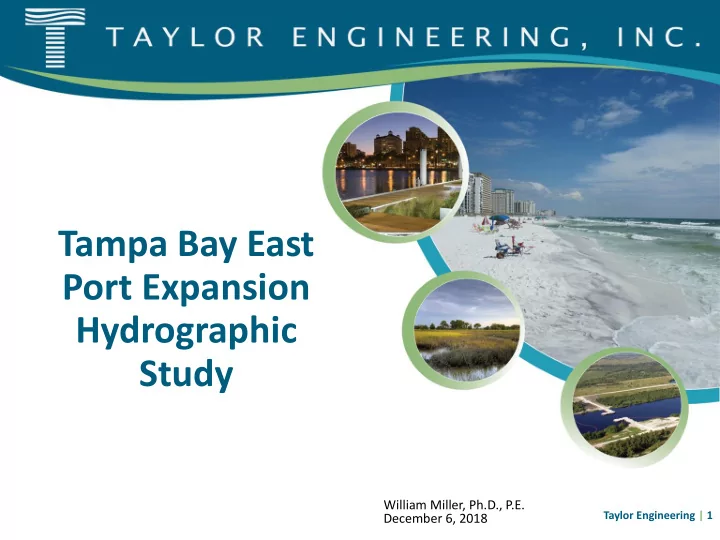

Tampa Bay East Port Expansion Hydrographic Study William Miller, Ph.D., P.E. Taylor Engineering | 1 December 6, 2018
Overview • Project Description • FDEP requirements • Satisfaction of FDEP requirements • Effects on McKay Bay Taylor Engineering | 2
Project Description Expansion of East Port with fill in East Bay and dredging portion of bay Taylor Engineering | 3
FDEP Flushing Requirements Section 10.2.4.3(b) of the statewide Environmental Resource Permit Applicant’s Handbook (FDEP, 2018 ) • Requires a hydrographic study to document the “ flushing time ” of the water at the docking facility • Flushing Time: “the time required to reduce the concentration of a conservative pollutant to ten percent of its original concentration ” • “flushing time of less than or equal to four days … for docking facilities” • pollutants “leaving the site of the docking facility will be adequately dispersed in the receiving water body so as to not cause violations of water quality standards based on circulation patterns and flushing characteristics of the receiving water body” Taylor Engineering | 4
Key FDEP Requirements • Reduce concentration of “conservative pollutant” to less than 10% of original concentration in less than 4 days • Not adversely affect adjacent waters (receiving body) • conservative pollutant: one that does not decay or settle out Taylor Engineering | 5
Physical Mechanism • How is pollutant concentration reduced? Advection/Dilution: tide and currents dilute pollutant over time by a physical exchange of water Diffusion: pollutant molecules disperse to areas of lower concentration • Both mechanisms modeled Taylor Engineering | 6
Numerical Model • US Army Corps of Engineers RMA2/RMA4 suite RMA2 models hydraulics (advection by tide and currents) RMA4 models pollutant transport (dilution and diffusion) RMA4 model uses the hydraulics from the RMA2 model Taylor Engineering | 7
RMA2 Model • Hillsborough Bay, East Hillsborough Palm River Bathymetry River (ft NAVD) Bay, and McKay Bay • Inputs from Hillsborough, Palm, and Alafia Rivers • Calibrated for water surface elevation (WSE) Alafia River and current speed Tampa Bay Taylor Engineering | 8
RMA2 Calibration of Existing Conditions Bathymetry Water Surface Elevation (ft NAVD) Velocity Calibration Points Water Surface Current Speed Calibration, Station V3 Elevation Model Results Measured Data 1.0 Calibration Points Current Speed 0.9 0.8 0.7 current speed (ft/s) 0.6 0.5 0.4 • Good WSE and current 0.3 0.2 calibrations 0.1 0.0 Taylor Engineering | 9
Modified Model • Modified Model to Bathymetry (ft NAVD) Include Fill and Proposed Dredged area Fill Area Dredging for Berths Dredged area Dredged area Taylor Engineering | 10
Pollutant Simulation • Simulate pollutant transport during neap and spring tides • Average diffusion coefficient of 12 m 2 /s • Observed values in estuaries: Avg. Range: 100 – 300 m 2 /s Low values: 10 – 50 m 2 /s Fischer et al. Mixing in Inland and Coastal Waters Taylor Engineering | 11
Tidal Flushing of Facility Neap Tide Minimal river discharges (65 cfs) D = 12 m 2 /s Flushing Time = 84 hrs Satisfies FDEP requirement 84 hrs Taylor Engineering | 12
Adjacent Waters • Second requirement M1 not to aversely M2 M7 affect adjacent M3 waters M6 M4 • Multiple sample E1 M5 points outside of facility E2 E3 T1 Taylor Engineering | 13
Concentrations in Adjacent Waters • Small increases in pollutant McKay Bay concentrations • Increases temporary as pollutant flushes from adjacent waters • Satisfies Second Requirement East Bay and Hillsborough Bay Taylor Engineering | 14
Effects of Project on McKay Bay • Hydraulic Effects • Effects on Ability to Remove Pollutants from McKay Bay Taylor Engineering | 15
Hydraulic Effects on McKay Bay • Water Surface Elevation Taylor Engineering | 16
Hydraulic Effects on McKay Bay • Discharge through causeway bridge Taylor Engineering | 17
Effects on Ability to Remove Pollutants • Simulate transport of Concentration (ppt) 1 substance beginning at Test Area 1 Test Area 2 McKay Bay NE McKay Bay NNE various locations in 2 McKay Bay • Simulate with and 4 3 without project • Compare 8 5 Test Area 3 residence/flushing time McKay Bay SW 6 of the substance 7 Taylor Engineering | 18
Modeled Effects on McKay Bay Concentration (ppt) Mean Change in RSMD Normalized Normalized Mean of Mean of Test Area Diff. Maximum T RES (hrs) (ppt) MD RSMD Maximum Maximum (ppt) Change Existing Project 1. McKay Bay NE 0 0.10 0.12 1.9% 2.3% 6.61 6.63 0.40 2. McKay Bay NNE 0 0.08 0.09 2.8% 3.2% 2.57 2.63 0.20 3. McKay Bay SW 0 0.09 0.10 2.1% 2.5% 5.04 5.04 0.30 • Minimal change in residence time • < 3% change in mean of maximum concentrations at all sample points • Maximum 0.2 – 0.4 ppt maximum difference over entire model run period Taylor Engineering | 19
Summary • Proposed project flushes within four-day FDEP requirement • Minimal effects on adjacent waters • Minimal effects on McKay Bay hydraulics • Minimal effects on McKay Bay flushing Taylor Engineering | 20
• Questions? Taylor Engineering | 21
Recommend
More recommend